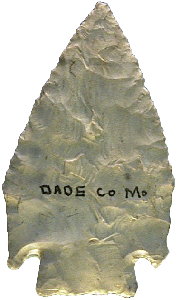

Point Type: AFTON
Also See: Jack's Reef, Rice Stemmed
Location: Midwestern States
Associated Dates:
5000 - 3000 B.P. - Middle Archaic
Morphology: Basal
Notched / Corner
Notched
General Description: The Afton is a medium to large sized dart point or knife form that is characterized chiefly by the angular outline of the blade. The angled upper one-half of the blade received most of the resharpening, indicating that this form was probably used as a knife with an angled cutting edge. The edges of the blade are roughly parallel toward the base but then angle abruptly to form a triangular shaped point. The blade is clearly divided into two distinct sections, the section from the barbs to the mid-point is commonly incurvate rather than straight in outline. This pentagonal shape sets this type apart and is why they have been called "Pentagonals" in Ohio. For the most part, this is a corner notched form however, some examples appear to be basally notched with notches more perpendicular than diagonal. The shoulders are prominent and barbed. The barbs are sometimes square in outline. The stem is short and straight to expanding. The basal edge is straight to slightly convex. There is very little or no basal grinding. This point is a Middle Archaic form.
The Afton is primarily found in the four-corners area of Missouri, Arkansas, Kansas and Oklahoma. A few have been found west of St. Louis. In Indiana and Ohio and the adjoining states, the Jack's Reef point is similar in appearance but it is later and was made by Late Woodland peoples. The major difference is that the Jack's Reef point is smaller and some are side notched as well as corner notched.
The average size of the Afton is between 51 mm and 102 mm in length. The type is fairly thin and flaking is is well executed using random percussion with pressure retouch. The Afton point was named by Robert E. Bell and Roland S. Hall in 1953 for Afton, Oklahoma where many points were found at a large spring.
About The Point Above: The Afton blade pictured at the top of this page, is obviously found in Dade County, Missouri and is from the former Townsend collection. It is made from Ozark white chert that has a light grey patina with very small light blue inclusions. It measures 78 mm in length, 43 mm wide and is only 5.5 mm at its thickest point (at the top of the base) with the majority of the blade being only 4 mm in thickness. The stem is 26 mm wide and is 10.5 mm long. The right barb has been slightly ground or abraded into a diminished size. Catalog Number 117-96-D
References: Bell (1), Cambron & Hulse, Dragoo (f), Overstreet, Perino (1), Puckett (1), Waldorf
© Copyright 1997 - 2008 LITHICS-Net WWW.LITHICSNET.COM
Use Your Browser's BACK Button to Return to the LITHICS-Net Index.